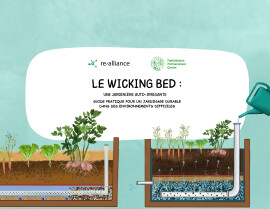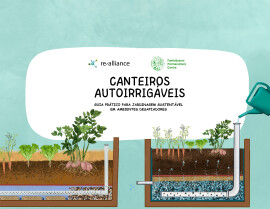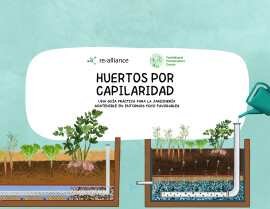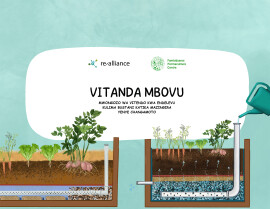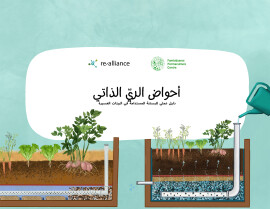
Participatory Livestock Research
A guide
This book is the first to offer an introduction to participatory research for livestock development. Despite the attention paid to participatory research methodologies in other areas of agricultural development, participatory livestock work has been relatively neglected despite the evident relevance of and demand for such approaches. This book will bring livestock researchers and practitioners up to date with the latest and best practice in participatory research.
Participatory Livestock Research will help researchers and practitioners to overcome the potential difficulties associated with participatory livestock research. The book shows how a participatory approach to technology development can be successful. It also shows how to undertake needs assessment using participatory approaches, and how to avoid the problems associated with on-farm livestock experiments. Participatory Livestock Research is essential reading for all those involved in livestock research and will be also be of interest to workers and researchers interested in wider agricultural development issues in universities, national agricultural research systems and NGOs, and extension workers and practitioners in agricultural service agencies.
Published: 2005
Pages: 320
eBook: 9781780440316
Paperback: 9781853395772
Participatory Livestock Research will help researchers and practitioners to overcome the potential difficulties associated with participatory livestock research. The book shows how a participatory approach to technology development can be successful. It also shows how to undertake needs assessment using participatory approaches, and how to avoid the problems associated with on-farm livestock experiments. Participatory Livestock Research is essential reading for all those involved in livestock research and will be also be of interest to workers and researchers interested in wider agricultural development issues in universities, national agricultural research systems and NGOs, and extension workers and practitioners in agricultural service agencies.
| Prelims (Contents, List of Figures, List of Tables, List of Boxes, Acknowledgements, List of Acronyms) | |||
|---|---|---|---|
| 1. Introduction: Why livestock is important to resource-poor people | |||
| PART I - PARTICIPATORY SITUATION ANALYSIS | |||
| 2. General aspects of participatory situation analysis | |||
| 3. Getting an overview of livestock-keeping; Feeding systems and resources | |||
| 4. Animal health; Analysis of constraints, problems and opportunities | |||
| PART II - PARTICIPATORY TECHNOLOGY DEVELOPMENT | |||
| 5. When to do participatory trials | |||
| 6. Getting started; Designing trials and experiments | |||
| 7. Monitoring and evaluation of experiments | |||
| 8. Achieving wider impact | |||
| PART III - CASE STUDIES | |||
| 9. Case study A: Learning about the control of Newcastle disease with village chicken farmers in Mozambique | |||
| 10. Case study B: Participatory development of mange treatment technology in Kenya | |||
| 11. Case study C: Participatory validation of medicinal plants for livestock diseases of pastoralists in Kenya | |||
| 12. Case study D: Improving the efficacy of concentrate usage by smallholder dairy farmers in Kenya | |||
| 13. Case study E: Tree pods as a supplement to improve the productivity of female goats in India | |||
| 14. Case study F: Women, livestock and innovation: campesino experimentation in Mexico | |||
| 15. Case study G: Adoption and scaling up – experiences of the Forages for Smallholders Project in South-east Asia | |||
| 16. Case study H: Development of herbaceous forage legume technologies in central Kenya | |||
| 17. Case study I: Development of the Kebkabiya donkey plough in Western Sudan | |||
| 18. Case study J: Tzotzil shepherdesses and Chiapas wool sheep, Mexico | |||
| PART IV - CONCLUSIONS | |||
| 19. Maximizing the contribution of participatory livestock research | |||
| Back Matter (Appendix: Internet-based livestock and development information sources, List of contributors, References, Index) |
Czech Conroy
Czech Conroy is Reader in Rural Livelihoods at the Natural Resources Institute, University of Greenwich. He has worked in various countries in Asia and Africa, and has done livestock-related work in India, Indonesia and Oman.
Economic Analysis of Animal Genetic Resources and the Use of Rural Appraisal Methods: Lessons from Southeast Mexico
Drucker, Adam G.
Anderson, Simon
International Journal of Agricultural Sustainability, Vol. 2 (2004), Iss. 2 P.77
https://doi.org/10.1080/14735903.2004.9684569 [Citations: 23]Mixed cereal silage as a forage complement to Kikuyu grass grazing for small-scale dairy systems in the dry season
Carrillo-Hernández, Sirley
Velarde-Guillén, José
López-González, Felipe
Arriaga-Jordán, Carlos Manuel
Tropical Animal Health and Production, Vol. 57 (2025), Iss. 6
https://doi.org/10.1007/s11250-025-04500-w [Citations: 0]Multi-species pastures for grazing dairy cows in small-scale dairy systems in the highlands of Mexico
Muciño-Álvarez, Mónica
Albarrán-Portillo, Benito
López-González, Felipe
Arriaga-Jordán, Carlos M.
Tropical Animal Health and Production, Vol. 53 (2021), Iss. 1
https://doi.org/10.1007/s11250-021-02564-y [Citations: 6]Barley or black oat silages in feeding strategies for small-scale dairy systems in the highlands of Mexico
Gómez-Miranda, Aída
Estrada-Flores, Julieta Gertrudis
Morales-Almaraz, Ernesto
López-González, Felipe
Flores-Calvete, Gonzalo
Arriaga-Jordán, Carlos Manuel
Plaizier, J.
Canadian Journal of Animal Science, Vol. 100 (2020), Iss. 2 P.221
https://doi.org/10.1139/cjas-2018-0237 [Citations: 8]Surveying animal genetic resources to manage biodiversity
Woolliams, John A.
Pilling, D.
Scherf, B.
Animal Genetic Resources/Ressources génétiques animales/Recursos genéticos animales, Vol. 47 (2010), Iss. P.23
https://doi.org/10.1017/S2078633610001049 [Citations: 2]Oat and ryegrass silage for small-scale dairy systems in the highlands of central Mexico
Celis-Alvarez, Maria Danaee
López-González, Felipe
Martínez-García, Carlos Galdino
Estrada-Flores, Julieta Gertrudis
Arriaga-Jordán, Carlos Manuel
Tropical Animal Health and Production, Vol. 48 (2016), Iss. 6 P.1129
https://doi.org/10.1007/s11250-016-1063-0 [Citations: 31]A Revolution Whose Time Has Come? The Win-Win of Quantitative Participatory Approaches and Methods
Chambers, Robert
IDS Bulletin, Vol. 41 (2010), Iss. 6 P.45
https://doi.org/10.1111/j.1759-5436.2010.00181.x [Citations: 10]Intensive grazing and maize silage to enhance the sustainability of small-scale dairy systems in the highlands of Mexico
Prospero-Bernal, Fernando
Martínez-García, Carlos Galdino
Olea-Pérez, Rafael
López-González, Felipe
Arriaga-Jordán, Carlos Manuel
Tropical Animal Health and Production, Vol. 49 (2017), Iss. 7 P.1537
https://doi.org/10.1007/s11250-017-1360-2 [Citations: 38]Water footprint of small-scale dairy farms in the central coast of Peru
Velarde-Guillén, José
Viera, Mario
Gómez, Carlos
Tropical Animal Health and Production, Vol. 55 (2023), Iss. 1
https://doi.org/10.1007/s11250-022-03437-8 [Citations: 4]Dairy goat performance in two grazing regimes: silvopastoral rangeland or abandoned agricultural land, and two supplementation treatments in central Mexico
Sainz-Ramírez, Aurora
Castro-Montoya, Joaquín M.
López-González, Felipe
Arriaga-Jordán, Carlos Manuel
Tropical Animal Health and Production, Vol. 56 (2024), Iss. 4
https://doi.org/10.1007/s11250-024-03997-x [Citations: 1]Participatory Mapping and Geographic Information Systems: Whose Map? Who is Empowered and Who Disempowered? Who Gains and Who Loses?
Chambers, Robert
THE ELECTRONIC JOURNAL OF INFORMATION SYSTEMS IN DEVELOPING COUNTRIES, Vol. 25 (2006), Iss. 1 P.1
https://doi.org/10.1002/j.1681-4835.2006.tb00163.x [Citations: 260]Oat silage for grazing dairy cows in small-scale dairy systems in the highlands of central Mexico
Burbano-Muñoz, Victor Andrés
López-González, Felipe
Estrada-Flores, Julieta Gertrudis
Sainz-Sánchez, Pedro Alan
Arriaga-Jordán, Carlos Manuel
African Journal of Range & Forage Science, Vol. 35 (2018), Iss. 1 P.63
https://doi.org/10.2989/10220119.2018.1473493 [Citations: 13]Fatty acid profile in milk of cows fed triticale silage in small-scale dairy systems in the highlands of central Mexico
Colín-Navarro, Vianey
López-González, Felipe
Morales-Almaráz, Ernesto
González-Alcántara, Felipe de Jesús
Estrada-Flores, Julieta Gertrudis
Arriaga-Jordán, Carlos Manuel
Journal of Applied Animal Research, Vol. 49 (2021), Iss. 1 P.75
https://doi.org/10.1080/09712119.2021.1884082 [Citations: 2]Communal Land Use in the Yungas of Jujuy and Salta Provinces (Argentina): Transhumance and Edible Plants in Valle Colorado
Morandini, Marcelo Nahuel
Oyharzabal Castro, Aimé
Solá, Rodolfo Ricardo
Pinciroli, Laura
Urtasun, María Manuela
Lamas, Carola Yanina
Giamminola, Eugenia Mabel
Sharry, Sandra Elizabeth
Human Ecology, Vol. 53 (2025), Iss. 3 P.437
https://doi.org/10.1007/s10745-025-00606-9 [Citations: 0]Dynamics of tall fescue (Festuca arundinacea) and Kikuyu grass (Cenchrus clandestinus) pastures associated with white clover (Trifolium repens) in small-scale dairy systems in the highlands of central Mexico
Plata-Reyes, Dalia Andrea
Martínez-García, Carlos Galdino
Hernández-Mendo, Omar
Arriaga-Jordán, Carlos Manuel
African Journal of Range & Forage Science, Vol. 40 (2023), Iss. 4 P.335
https://doi.org/10.2989/10220119.2022.2144946 [Citations: 1]Constraint analysis to improve integrated dairy production systems in developing countries: The importance of participatory rural appraisal
Devendra, C.
Tropical Animal Health and Production, Vol. 39 (2007), Iss. 8 P.549
https://doi.org/10.1007/s11250-007-9060-y [Citations: 11]Forage conservation in sub‐Saharan Africa: Review of experiences, challenges, and opportunities
Balehegn, Mulubrhan
Ayantunde, Augustine
Amole, Tunde
Njarui, Donald
Nkosi, Bhutikini D.
Müller, Francuois L.
Meeske, Robin
Tjelele, Tlou J.
Malebana, Ingrid M.
Madibela, Othusitse R.
Boitumelo, Wame S.
Lukuyu, Ben
Weseh, Addah
Minani, Elias
Adesogan, Adegbola T.
Agronomy Journal, Vol. 114 (2022), Iss. 1 P.75
https://doi.org/10.1002/agj2.20954 [Citations: 49]Cow performance and methane emissions from sorghum silage diets in small-scale dairy systems of Central Mexico
Sainz-Ramírez, Aurora
Morales-Cruz, Alejandro Adelaido
López-González, Felipe
Arriaga-Jordán, Carlos Manuel
Tropical Animal Health and Production, Vol. 57 (2025), Iss. 8
https://doi.org/10.1007/s11250-025-04637-8 [Citations: 0]Implementing the UNCCD: Participatory challenges
Stringer, Lindsay C.
Reed, Mark S.
Dougill, Andrew J.
Seely, Mary K.
Rokitzki, Martin
Natural Resources Forum, Vol. 31 (2007), Iss. 3 P.198
https://doi.org/10.1111/j.1477-8947.2007.00154.x [Citations: 48]Participatory study of medicinal plants used in the control of gastrointestinal parasites in donkeys in Eastern Shewa and Arsi zones of Oromia region, Ethiopia
Scantlebury, Claire E
Peachey, Laura
Hodgkinson, Jane
Matthews, Jacqui B
Trawford, Andrew
Mulugeta, Getachew
Tefera, Gebre
Pinchbeck, Gina L
BMC Veterinary Research, Vol. 9 (2013), Iss. 1
https://doi.org/10.1186/1746-6148-9-179 [Citations: 20]
